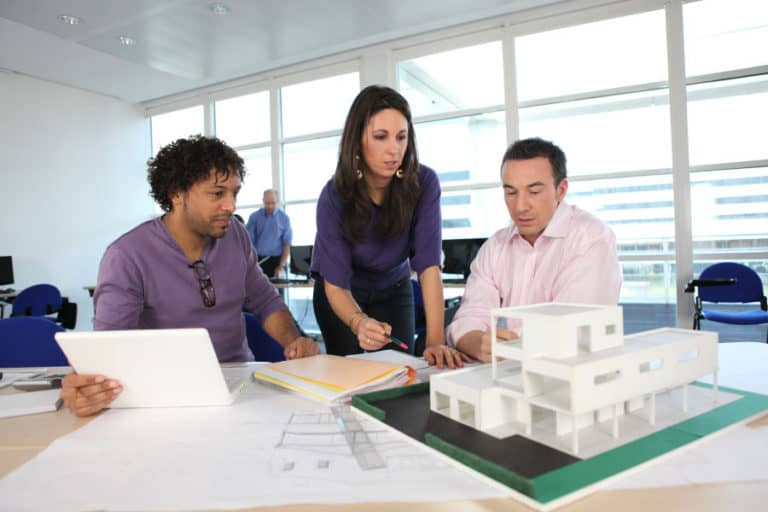Do I Need an Architect, a Contractor or an Engineer?
Architects, contractors, and engineers can be considered the big three professions in the building industry. These three professions make sure that buildings are beautiful, work well, are built well, and are safe to use.
An architect is generally in charge of the flow of the project, the contractor is in charge of the construction-side of the project, and the engineer is in charge of making sure that a building is structurally sound. Any project that involves four walls and a roof will normally require that you get all three of these professionals on board.
Read more if you want to learn about what these professionals do when you need to hire these professionals, and the other professionals needed to make a construction project work.
When is it required to get professionals for a construction project?
The requirement of getting professionals in a project largely depends on the size and intended function of a given space.
For example, you wouldn’t need an architect, contractor, and engineer for a shed, but you will need them to have a garage built.
You need to understand the rationale behind getting a professional, which is to ensure the safety and functionality of a given space. Without these professionals, you could end up with disastrous buildings.
Believe it or not, there are a lot of buildings that are either misdesigned (common misdesigns are low ceilings), installations (toilets don’t flush properly), and miscalculations in the structural integrity (sinking houses).
Getting professionals is best when you need a structure designed with an intended purpose and a size that allows for human activity, unlike a shed, which is just for storage.
What does an architect do?
The architect is in charge of mainly designing the building and most likely will also be in charge of the project. Architects are in charge of ensuring that the client’s vision is met with a design that serves its functions, meets the client’s image of what the building should be, and should also be in respect to its environment.
Aside from this, architects are also heavily involved throughout the construction process. They make sure that the contractor and the foreman follow the plan and the specifications. The specifications are usually a booklet created by an architect that lists how the building should be exactly built and with what materials (Ex. Walls of these rooms must be painted with a certain finish).
Lastly, the architect closes the project by doing a final assessment, checking if everything is in order and done correctly.
What does a contractor do?
The contractor is in charge of overseeing the construction of the building. They are responsible for getting the necessary logistics, manpower, documents, etc., needed for a building.
Contractors need to know the ins and out of everything related to a building, in the physical sense. They need to know how certain installations are built, how to work with certain materials, the safety precautions needed throughout construction, etc.
How contractors can do this is by having a large network of different suppliers, workers, and their own inventory. Contractors also need to be well-versed in all the requirements, set by the building law or by the government, to ensure that the building can be built in a safe and reduce the impact that the construction may have on the nearby area (prevent falling debris, reduce noise, avoid the spread of dust, etc.)
What does an engineer do?
Engineers ensure that the building is capable of performing its function as efficiently as possible and ensuring that the building is structurally sound.
- The civil engineer is in charge of making sure that the building can handle the multiple forces that it experiences. Forces such as these can range from human activity, appliances, fixtures, wind, water, etc. The civil engineer takes all of these into account and makes calculations, based on the architect’s design, to assess if the design is capable of safely handling said forces.
- The electrical engineer is in charge of ensuring that all of the appliances and fixtures throughout a building receive ample amounts of power, enough to supply its necessary functions. These tasks revolve around strategic planning of electrical layouts, ensuring that the electric grid is functioning, especially for emergency times. Remember that an electrical engineer is NOT an electrician. An electrical engineer designs the electrical system while an electrician installs it.
- The mechanical engineer is in charge of ensuring that all the inner mechanisms of a building are well functioning and efficient. Said mechanisms might include air ducts, elevators, escalators, air conditioning, conveyor belts, etc. These all involve ensuring that all of these mechanisms are installed properly and are in ideal conditions.

The relationship between the architect and the contractor
The architect and the contractor need to be in constant communication throughout the construction process. The architect needs to make sure that the building is being built in accordance with the specifications. Contractors and architects often need to discuss changes in the plans, especially if certain conditions do not allow the architect’s specifications to be built as-is.
The relationship between the architect and the engineer
The architect and the engineer need to collaborate throughout the design process. Civil engineers work with an architect by offering alternatives or recommendations to make the building more structurally sound. The architect’s design needs to always be in consideration of the specifications dictated by the engineer. This includes space sizing, column placement, fixture placement, etc.
The relationship between the engineer and the contractor
The engineer and the contractor don’t really talk that much throughout the entirety of the project. Only in certain scenarios will a contractor need to consult with an engineer since everything the engineer has specified is already present in the architect’s plans.
Do you still need an architect, a contractor, or an engineer for a renovation?
- For large-scale renovations, you would need all three. Large-scale renovations can be defined as renovations that will require a complete overhaul of a building’s component. Renovations that change the structural layout or add a sizable amount of space can be considered large-scale renovations.
- For medium-scale renovations, you would preferably need only an architect and a contractor. Medium-scale renovations are renovations that do not change the current structural layout of the building. These renovations can be a complete interior redesign, change of floor layout(while still maintaining the column grid), etc. are what can be considered medium-scale renovations.
- For small-scale renovations, you do need to hire any professionals. These renovations usually only require hiring an experienced carpenter or handyman. Small-scale renovations are renovations that do not require any heavy-duty tools and can be completed by a small group of workers. An example of a small-renovation is a change of the finish of a space, repainting, installing fixtures, etc.
We’ll now be going into what these professionals can do if you decide to hire them for a renovation project.
Architect for renovations?
An architect can help direct how you can modify your house to achieve what you want in the cheapest way possible. You don’t really need to hire an architect for this type of project, but instead, you can opt to have consultations with them throughout the project.
The architect can help you decide which modifications (minor changes) would work best to get what you want out of the renovation project. This makes it easier to work with the contractor since you now have a concrete plan on what you want to achieve with your renovation project.
Contractor for renovations?
Contractors are perhaps the main professionals you’ll be working with if you plan on doing a renovation. Since renovations limit both an architect and engineer’s duties, the contractor will most likely be the one you should be talking to since most renovations are just reinstallations, minor changes, and finish changes within the building.
Contractors will still play the same role, which is to provide the necessary logistics for the project and overlook the project’s completion since renovations are generally smaller-scale.
Engineer for renovations?
Hiring an engineer will be needed if your renovation requires that you change a certain structural aspect of a building or make structural repairs. An example of this would be a failing foundation, which would be costly and would eventually compromise the safety of the building.

How to choose the right professionals
The best way to choose who to hire is to look at the past projects they’ve worked on. As much as resumes and reputation come along, looking at a professionals’ past projects allows you to determine if you want the same results for your project.
Remember, there are almost endless ways of getting the same thing done in the construction industry. Everyone works differently, and each professional has their own method of getting things done.
At the end of the day, the best projects always come from good communication and having the same goals. Even outside the construction industry, this will always hold true.
What’s expected from the client in a project?
From the client’s point of view, most of the time, they only need to work and communicate with the architect and the contractor unless they specifically hired other professionals.
Architects are usually paid around 5-10%, depending on how involved they are in the project because they’re the ones in charge of working with all these professionals. An architect’s plans need to be approved by different professionals before a building official can approve them. This ensures that the architect’s plans are correct in all aspects, whether structurally, mechanically, electrically, etc.
As mentioned earlier, the client will be discussing with the architect how they want the building to turn out. It is up to the architect to coordinate with the other professionals on how to meet these requirements. The client no longer needs to talk to all of the professionals because of this, since the architect serves as the “representative.”
On the contractor side, they’ll be initially bid for the project. The client will be the one to choose which contractor they want to go with. Usually, it’s best to choose a contractor with the best value, meaning that you’re getting the most value per dollar spent, rather than choosing whatever is cheapest.
The client will constantly be receiving updates from the contractor based on the progress, which should be within a construction schedule.
There will be key decisions or changes that will be needed to be made throughout the process of having a building or design built. It’s the architect and the contractor’s responsibility to let the client know if there’s anything that needs to be changed.
These changes can range anywhere from column placement to a redesign of a section of a building with causes ranging from budget concerns, structural concerns, or a notice from a building official.
Other professions you’ll need to hire
Aside from these big three professions that people often associate with buildings, you might also need to hire other professions. Some of these professions are also required in a project, while others are at the client’s behest.
- Geodetic Engineer
The geodetic engineer checks the current soil and the topography of the lot. This is essential because it gives the architect and the engineer the necessary information to ensure that the house can stand up to the limit the soil can hold.
Remember that not all soil is the same. The usual basis for soil and it’s structural capacity is based on the sizes of the soil. The finer the soil, the more structural intervention will be required to make sure the building can hold up.
Getting a geodetic engineer is mandatory.
- Landscape Architect
A landscape architect is the designer of the environment surrounding a building. Just like an architect, they design the outdoor areas in such a way that beautifies the building and its nearby surroundings. Hiring a landscape architect is optional but highly recommended, especially for structures with a big lot size.
- Master Plumber
The master plumber is in charge of ensuring that your water system and sewage system are all in check. Master plumbers are different from regular plumbers. Master plumbers design the water system while plumbers install/repair them.
Getting a master plumber is mandatory for any structure.
- Building Official
You might be wondering why a building official is on this list. It may be a surprise to you, but you need to pay the building official to inspect your house to get the proper approval and permits needed to use the house.
Building officials are professionals too. In fact, they’re most likely have a background in architecture and are there to make sure that your building is compliant with all the rules and regulations.
- Accountant
With all this hiring, someone’s gotta keep track of all the spending. Getting an accountant is optional but highly suggested, especially for a bigger project, in addition to your team of professionals, when it comes to constructing buildings.
Tracking your finances throughout your project is essential to make sure that everything will run smoothly. The last thing you would want is to overspend on a project!
- Construction workers and Security
Most likely, this will be under the contractor as part of their proposal throughout the bidding phase, but you’ll also need to hire construction workers and security throughout the construction phase of your project.

What it means to be an ideal client
The biggest time and money saver on the client’s side is knowing how to communicate and coordinate well with the architect and contractor.
The client should ideally, and also in their best interest, be as efficient as possible when it comes to making decisions throughout a project. The performance of the professionals rests heavily on how the client makes decisions, as their work will be based on what the client wants.
As we mentioned earlier, choosing the right professionals is important so that the project can be completed smoothly.
Being an ideal client entails knowing exactly what you want, having the right budget (and an emergency extra just in case), as well as having at least a basic understanding of how a construction project usually goes.
The biggest part of being an ideal client is knowing exactly what you want. It’s not uncommon for clients to change their minds in the middle of the design process or even during the construction phase.
- Knowing exactly what you want
Constantly giving your architect feedback is important because it allows the professional to be better equipped to produce whatever you have in mind. Simple modifications like a change of finish, change of layout, etc., can delay a project by a considerable amount of time.
- Communicate as honestly and as concretely as possible.
Instead of saying that you want a space to be more lively or look better, instead, ask for XY finish or YX furniture. An architect can only interpret vague statements and will most probably end up designing something a bit far off from what you want if you only give them this type of information.
- Have a general idea of what’s going on and why it’s going on.
Considering that having a structure built is a large investment on the client’s end. It’s not unreasonable to assume that they should also study how a structure should be built. Having a somewhat basic background allows the client to make better decisions and understand where the different professionals are coming from.
- Building relationships
It goes without saying that having a building built requires that the client has a lot of trust in the honesty of the professionals working on the project. It helps a client build rapport with their architect and contractor to have a good working relationship, which helps reduce the stress that a project can bring to everyone involved.
- Know when to defer to the professionals
There will inevitably be some conflict between what the clients want and what the architect/contractor thinks should be. As a client, you should understand first where the professional is coming from based on their expertise before arriving at a decision to make. Ask yourself whether the changes that the architect/contractor is proposing is beneficial to your project and if that benefit outweighs what you currently want out of the project.
What happens if you decide not to hire professionals?
Not hiring any professionals for a project, and instead, going with unlicensed professionals for a lower price is a recipe for disaster. Without any regulation or guaranteed knowledge, it’s pretty much guaranteed that something will go wrong during a project.
These disasters can be:
- Structural failure
- Failure to comply with building code
- Incorrect construction method
- No approval from the building official
- Incorrect and inefficient designs
- Having no timeline at all
- Possibility of getting scammed
- And many more.
Remember, there’s a reason why any project requires a substantial amount of money needed to invest in it. If a non-professional were to tempt you to acquire their services for less than that of a professional, it’s probably a sign that something is wrong.
A classic example of this would be asking a non-architect to design a home for you. They would usually offer a price around half of that of which an architect promises.
Let’s say, for example, you save $5000 by hiring a non-professional. What ends up happening is that the house would be extremely inefficient in energy use, would not have sufficient space for activities, and require constant maintenance and renovations.
A conservative estimate is that you would spend an extra $100 a month because of all these factors considered and including the time spent on these repairs.
In a ten-year span that would amount to a wasted $12,000.
If you were to hire an architect, for example, for $10,000, the house would be easy to maintain, would not require any renovations or repairs as much, and would most likely be more aesthetically pleasing. These are just a few out of the many benefits that you can get from getting an architect.
Getting an architect and hiring professionals should be seen as an investment rather than an expense. Let’s use an extremely conservative estimate if we use the example earlier and say you save $50 a month. That totals to $6000 in 10 years, but that doesn’t include it’s beautiful and functional design. With that said, your home’s total value will definitely increase far beyond what you initially paid the architect.
Professionals work and study hard to get where they are today. They get paid well for a reason, and not just anybody can do what they do. In the same way that you wouldn’t want to undergo an operation with an unlicensed doctor, you should avoid unlicensed professionals at all costs.
Firms
If you personally don’t know any architects, the best place to look for one would be from a firm. Working with an architectural firm is great because they already have partnerships with all the different professionals needed for a project; think of it as a package deal.
Like with anything, working with a firm will have its pros and cons too.
Firms will be a bit more costly compared to working with an architect you personally know. However, this price is well worth it because of how assured you are of the quality of their work.
Firms have a working environment with multiple architects helping each other design and plan out buildings. Architects in a firm are assigned different roles and form teams, depending on the scale of the project. For a house project, you may have around 1-2 architects working on it.
Aside from that, firms usually already have their own in-house engineers and partnerships with reliable contracts that they have already worked with before. This is great for that collaboration and communication aspect we discussed earlier.
For payment, you pay the firm rather than the professionals themselves. Firms usually charge 10% of the project’s total cost and pay their architects a fixed salary instead.
Conclusion
In conclusion getting an architect, a contractor, and an engineer is essential for any construction project used by people. These professionals handle the planning, logistics, documentation, construction, safety, and many more throughout the entirety of the project.
Professionals always collaborate and work together throughout a project. Coordination of plans and progress allows the professionals to ensure that the building is sufficient to meet its intended function.
Clients are also expected to be engaged within a project. Communication between the client and the different professionals is important to ensure that everything is in line with what the client wants and needs from the building.







